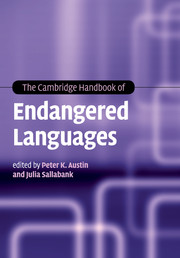Crossref Citations
This Book has been
cited by the following publications. This list is generated based on data provided by Crossref.
McCarty, Teresa L.
2012.
The Encyclopedia of Applied Linguistics.
Rice, Keren
2014.
The Cambridge Handbook of Linguistic Anthropology.
p.
285.
Timo, Omer L. Nguena
and
Bissyandé, Tegawendé F.
2014.
e-Infrastructure and e-Services for Developing Countries.
Vol. 135,
Issue. ,
p.
229.
Kockelman, Paul
Enfield, N. J.
and
Sidnell, Jack
2014.
The Cambridge Handbook of Linguistic Anthropology.
p.
183.
Baron, Naomi S.
2015.
The International Encyclopedia of Communication.
Léonard, Jean Léo
2015.
Florian Siegl : Materials on Forest Énets, an indigenous language of northern Siberia.
Études finno-ougriennes,
Tershy, Bernie R.
Shen, Kuo-Wei
Newton, Kelly M.
Holmes, Nick D.
and
Croll, Donald A.
2015.
The Importance of Islands for the Protection of Biological and Linguistic Diversity.
BioScience,
Vol. 65,
Issue. 6,
p.
592.
2015.
The Concise Encyclopedia of Communication.
p.
322.
Thieberger, Nick
2016.
Documentary Linguistics: Methodological Challenges and Innovatory Responses.
Applied Linguistics,
Vol. 37,
Issue. 1,
p.
88.
Hinton, Leanne
2016.
Language Policy and Political Issues in Education.
p.
1.
Grenoble, Lenore A.
2016.
A response to ‘Assessing levels of endangerment in the Catalogue of Endangered Languages (ELCat) using the Language Endangerment Index (LEI)’, by Nala Huiying Lee & John Van Way.
Language in Society,
Vol. 45,
Issue. 2,
p.
293.
Mufwene, Salikoko S.
2016.
Endangered Languages and Languages in Danger.
Vol. 42,
Issue. ,
p.
115.
Maude, Barry
2016.
Managing Cross-Cultural Communication.
p.
19.
2016.
Revitalising Language in Provence: A Critical Approach.
Transactions of the Philological Society,
Vol. 114,
Issue. S1,
p.
1.
Filipović, Luna
and
Pütz, Martin
2016.
Endangered Languages and Languages in Danger.
Vol. 42,
Issue. ,
p.
1.
Engerer, Volkmar
2017.
Control and syntagmatization: Vocabulary requirements in information retrieval thesauri and natural language lexicons.
Journal of the Association for Information Science and Technology,
Vol. 68,
Issue. 6,
p.
1480.
Edwards, John
2017.
Celtic languages and sociolinguistics: a very brief overview of pertinent issues.
Language, Culture and Curriculum,
Vol. 30,
Issue. 1,
p.
13.
Che, Dongsheng
Shafer, Taylor
and
Tian, Pu
2017.
Classification of endangered languages using decision tree based algorithms.
p.
1814.
Gasquet-Cyrus, Médéric
Vittrant, Alice
and
Voisin, Sylvie
2017.
Présentation : Langues en danger et théories linguistiques : perspectives croisées.
Histoire Epistémologie Langage,
Vol. 39,
Issue. 1,
p.
9.
Hinton, Leanne
2017.
Language Policy and Political Issues in Education.
p.
257.





